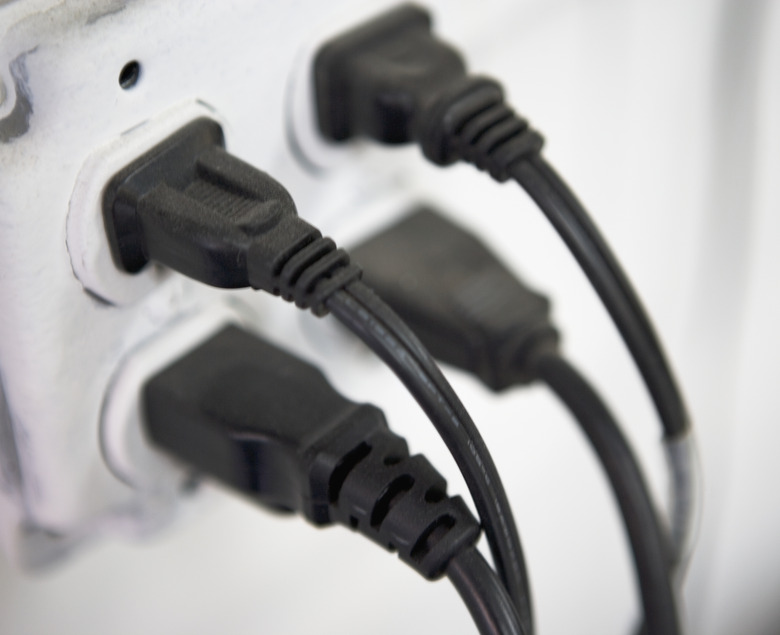How To Install A Quad Electrical Outlet
What's better than a duplex outlet? Two duplex outlets! The configuration whereby a pair of duplex outlets occupy the same electrical box is called a quad outlet or a quad receptacle. It allows you to keep your TV and sound system plugged in while you plug in a room light, and it still leaves a free outlet for the vacuum cleaner. Quad outlets are safer than outlet multipliers, but there's nothing stopping you from plugging a multiplier or an exto, which is a quad outlet on an extension cord, into one of the outlets in the quad receptacle to get even more functionality. Nothing, that is, except the possibility of overloading the circuit. To prevent this, you can wire each duplex outlet in the quad receptacle to a different circuit.
You May Need a Quad Box
You May Need a Quad Box
If you want to convert an existing duplex outlet to a quad outlet, you're going to need a bigger electrical box. A quad box is nothing more than a conventional double-gang electrical box. Electrical boxes are typically fastened to a stud, but you can buy remodeling, or old-work, boxes that anchor to the drywall.
To install an old-work quad box, you might first want to remove the existing single-gang box, but you don't have to. If you remove the wires from the box, you can simply cover the old box with drywall. The beauty of an old-work box is that it can be installed anywhere on the wall, not just next to a stud. It's a great solution if you want to install a brand-new outlet where none already exists or you want to keep the existing duplex and install a quad receptacle nearby.
Installing Both Duplexes on the Same Circuit
Installing Both Duplexes on the Same Circuit
Before starting any electrical wiring project, it's important to make sure the power is off. Turn off the breaker that controls the circuit. Then, just to be sure, test the wires with a voltage tester before you touch them.
You'll need a cable in the box that connects to a live circuit, either coming directly from the panel or branching from an existing device, such as an outlet. You'll also need three 6-inch lengths of spare wire, one black, one white and a bare one for ground. If you're going to branch off the quad outlet to power another device, you'll also need a cable that runs to that device. Make sure both cables, as well as the three jumper wires, are the same gauge.
Start by connecting the live circuit wire to one of the receptacles. The black wire connects to one of the brass screws (it doesn't matter which one) and the white wire connects to the corresponding chrome terminal on the other side of the receptacle. After tightening the screws with a screwdriver, connect the black jumper wire to the unused brass terminal and the white jumper to the unused chrome one. Tighten the screws. Wrap the bare wire around the ground screw, but don't tighten this screw just yet.
To hook up the second outlet, connect the black jumper to one of the brass terminals and the white wire to one of the chrome ones. If you have an outgoing cable, attach it to the unused terminals, black to brass and white to chrome. Wrap the ground wire around the ground screw. Now connect the ground screws by wrapping the bare jumper wire around both ground screws and tightening the screws. Screw both outlets into the box, install a quad receptacle cover plate and you're done.
Installing Each Outlet on a Separate Circuit
Installing Each Outlet on a Separate Circuit
The big difference when wiring the outlets on different circuits is that you need two live cables that draw power from different circuits. Connect one cable to the first receptacle – black to brass, white to chrome and ground to green – then connect the other cable to the second receptacle. If you have an outgoing cable, you can connect it to either receptacle, depending on which circuit is best able to handle the extra load.
Installing a Manufactured Quad Outlet
Installing a Manufactured Quad Outlet
If you want to keep the wiring job as simple as possible, purchase a quadplex outlet, which consists of four outlets in a single casing and fits into a conventional quad box. The outlets are already wired together and it has the same pairs of brass and chrome terminals as a conventional duplex receptacle. All you need to do is connect the live circuit wires to one set of terminals and the outgoing branch wires to the other set. Don't forget to attach the ground wires to the green ground screw.
